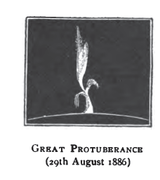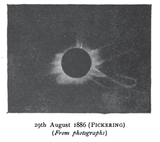Solar eclipse of August 29, 1886
| Solar eclipse of August 29, 1886 | |
|---|---|
 Map | |
| Type of eclipse | |
| Nature | Total |
| Gamma | -0.1059 |
| Magnitude | 1.0735 |
| Maximum eclipse | |
| Duration | 396 sec (6 m 36 s) |
| Coordinates | 3°30′N 15°18′W / 3.5°N 15.3°W |
| Max. width of band | 240 km (150 mi) |
| Times (UTC) | |
| Greatest eclipse | 12:55:23 |
| References | |
| Saros | 133 (38 of 72) |
| Catalog # (SE5000) | 9249 |
A total solar eclipse occurred on August 29, 1886. A solar eclipse occurs when the Moon passes between Earth and the Sun, thereby totally or partly obscuring the image of the Sun for a viewer on Earth. A total solar eclipse occurs when the Moon's apparent diameter is larger than the Sun's, blocking all direct sunlight, turning day into darkness. Totality occurs in a narrow path across Earth's surface, with the partial solar eclipse visible over a surrounding region thousands of kilometres wide.
Observations[]

|

|

|

|
References[]
- NASA graphic
- Mabel Loomis Todd (1900). Total Eclipses of the Sun. Little, Brown.
| Wikimedia Commons has media related to Solar eclipse of 1886 August 29. |
Categories:
- Total solar eclipses
- 1886 in science
- 19th-century solar eclipses
- August 1886 events


